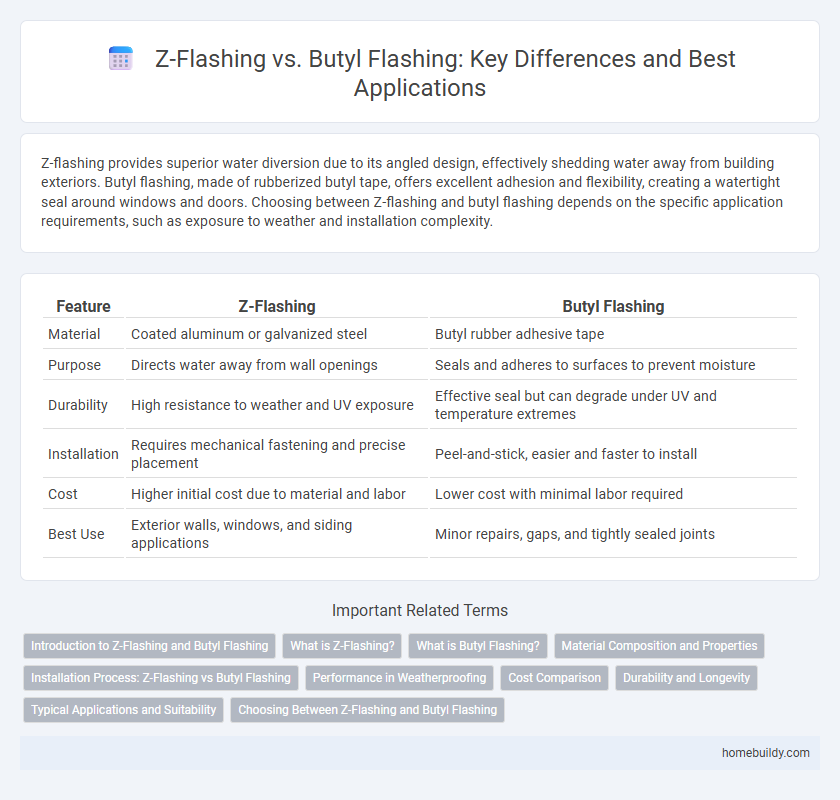Z-flashing provides superior water diversion due to its angled design, effectively shedding water away from building exteriors. Butyl flashing, made of rubberized butyl tape, offers excellent adhesion and flexibility, creating a watertight seal around windows and doors. Choosing between Z-flashing and butyl flashing depends on the specific application requirements, such as exposure to weather and installation complexity.
Table of Comparison
| Feature | Z-Flashing | Butyl Flashing |
|---|---|---|
| Material | Coated aluminum or galvanized steel | Butyl rubber adhesive tape |
| Purpose | Directs water away from wall openings | Seals and adheres to surfaces to prevent moisture |
| Durability | High resistance to weather and UV exposure | Effective seal but can degrade under UV and temperature extremes |
| Installation | Requires mechanical fastening and precise placement | Peel-and-stick, easier and faster to install |
| Cost | Higher initial cost due to material and labor | Lower cost with minimal labor required |
| Best Use | Exterior walls, windows, and siding applications | Minor repairs, gaps, and tightly sealed joints |
Introduction to Z-Flashing and Butyl Flashing
Z-flashing is a metal or vinyl strip designed to divert water away from wall joints to prevent moisture infiltration, commonly used in siding and window installations. Butyl flashing, made from butyl rubber adhesive, offers superior waterproof sealing and flexibility for irregular surfaces, ensuring a durable barrier against water intrusion. Both flashing types serve critical roles in building envelope protection, with Z-flashing providing physical water deflection and butyl flashing delivering adhesive waterproofing.
What is Z-Flashing?
Z-flashing is a metal flashing shaped like the letter "Z," designed to direct water away from window and door openings in building exteriors. It prevents moisture infiltration by creating a durable, corrosion-resistant barrier between siding and framing materials. Compared to butyl flashing, Z-flashing offers superior rigidity and long-term weather resistance, commonly used in wood-frame construction for effective water management.
What is Butyl Flashing?
Butyl flashing is a flexible, adhesive waterproofing material composed primarily of butyl rubber, designed to create durable seals around windows, doors, and roof penetrations. It offers superior adhesion to various surfaces, excellent UV resistance, and long-term flexibility, making it ideal for preventing water infiltration in building envelope applications. Compared to Z-flashing, butyl flashing provides a peel-and-stick installation method that enhances sealing performance and reduces installation time.
Material Composition and Properties
Z-flashing is typically made from rigid aluminum or vinyl, providing superior durability and resistance to weathering compared to butyl flashing, which is composed of a sticky, rubber-like synthetic polymer with strong adhesive properties. The metal or vinyl composition of Z-flashing allows for excellent water shedding and UV resistance, while butyl flashing offers flexibility and a strong seal ideal for irregular surfaces and seams. Material strength and longevity favor Z-flashing in exterior applications exposed to harsh environmental conditions, whereas butyl flashing excels in creating airtight and waterproof seals in detailed or tight areas.
Installation Process: Z-Flashing vs Butyl Flashing
Z-flashing installation involves securing metal strips over joints where siding meets other materials, requiring precise measurement and cutting to ensure water tightness. Butyl flashing uses a peel-and-stick adhesive membrane applied directly to the substrate, making it faster to install but dependent on surface cleanliness and temperature conditions for proper adhesion. Choosing between Z-flashing and butyl flashing depends on project demands for durability, ease of installation, and environmental exposure.
Performance in Weatherproofing
Z-flashing provides superior weatherproofing by effectively directing water away from critical joints, reducing the risk of moisture infiltration and enhancing durability in various climatic conditions. Butyl flashing offers strong adhesion and flexibility, making it suitable for sealing irregular surfaces, but it may degrade faster under prolonged UV exposure compared to Z-flashing. Overall, Z-flashing demonstrates enhanced long-term performance against water penetration, especially in areas prone to heavy rain and freeze-thaw cycles.
Cost Comparison
Z-flashing generally costs less than butyl flashing due to simpler materials and easier installation processes, reducing labor expenses. Butyl flashing, made from synthetic rubber, incurs higher upfront costs but offers superior durability and flexibility, potentially lowering maintenance costs over time. Evaluating initial investment against long-term benefits, Z-flashing provides a cost-effective solution for budget-conscious projects, whereas butyl flashing suits applications requiring enhanced weatherproofing and longevity.
Durability and Longevity
Z-flashing, made from rigid aluminum or galvanized steel, offers superior durability and longevity compared to butyl flashing, as it resists cracking, warping, and UV degradation over time. Butyl flashing, composed of a flexible rubberized material, can degrade faster when exposed to extreme weather, reducing its lifespan and effectiveness. In demanding climates, Z-flashing provides long-term protection against moisture intrusion and structural damage, making it the preferred choice for builders prioritizing extended performance.
Typical Applications and Suitability
Z-flashing is typically used in vertical applications such as window and door openings to deflect water away from the building envelope, making it ideal for areas prone to heavy rainfall or water intrusion. Butyl flashing, known for its superior adhesive properties and flexibility, is more suitable for sealing irregular surfaces and joints, providing enhanced waterproofing in challenging construction details. While Z-flashing excels in structural water diversion, butyl flashing offers better performance in airtight sealing for penetrations and irregular geometries.
Choosing Between Z-Flashing and Butyl Flashing
Z-flashing provides effective water diversion by creating a stepped barrier at siding transitions, while butyl flashing offers superior adhesion and flexibility for sealing joints and irregular surfaces. Choosing between Z-flashing and butyl flashing depends on the project's specific requirements, such as surface type, exposure to moisture, and installation complexity. Z-flashing is ideal for traditional siding overlaps, whereas butyl flashing excels in low-slope areas and applications needing a watertight seal around complex details.
Z-flashing vs butyl flashing Infographic

 homebuildy.com
homebuildy.com